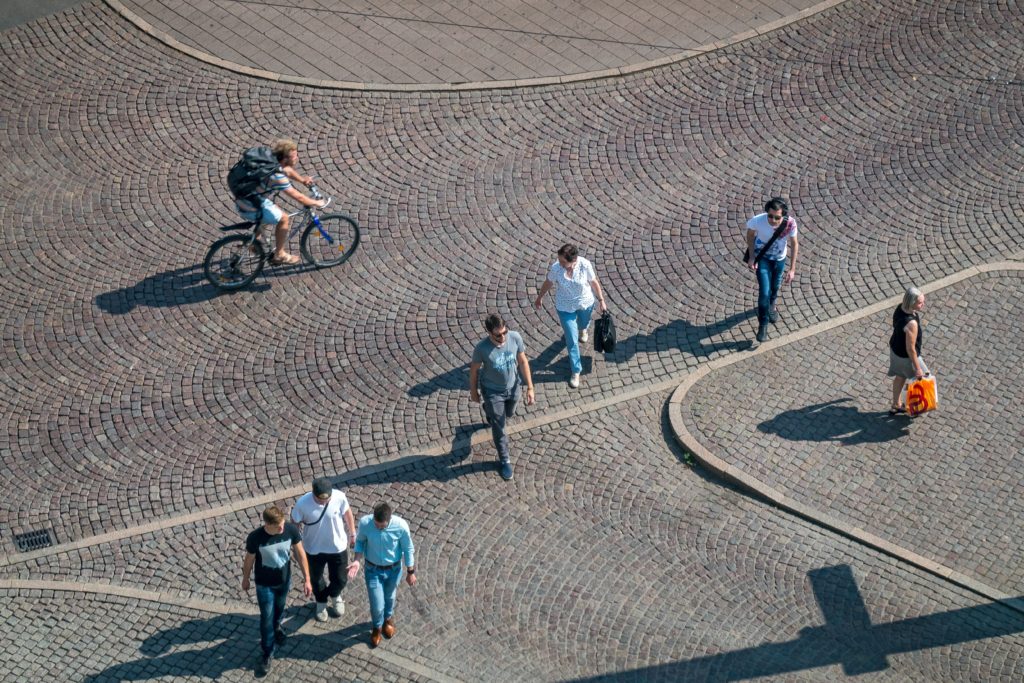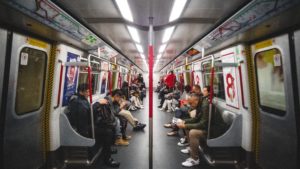Why is this important?
Light vehicles, including passenger cars, account for about a third of global oil demand and produce about half of all transportation-related greenhouse gas emissions. Soft mobility can significantly cut passenger car-related emissions.(1)
Key actions
-
#1 Bicycle parking
Install covered and secured bicycle parking.
-
#2 Provide facilities
Provide changing rooms and showers.
-
#3 Offer bike maintenance
Provide basic bike maintenance kit at the office (pump, patches).
-
#4 Provide financial incentives
Offer financial incentives (cover part of the cost of (e) bikes, provide mileage allowances).
-
#5 Organise green events
Join or organise events such as a Bike to Work or a Bike Repair Day.
-
#6 Facilitate bicycle access
Provide bikes for local business travels.
-
#7 Involve municipalities
Encourage the municipality to install bike-friendly infrastructure (paths, parking, bike-friendly trains).
-
#8 Join forces
Mutualise and join forces with other organisations following a similar approach.
To consider
-
Potential co-benefits
- Prevention of physical diseases (diabetes and cardiovascular disease)
- Improvement of sleep
- Mental health benefits
- Reduction of transportation costs
- Reduction of congestion
-
Success conditions
- Communication on organisational incentives
- Raising awareness among staff
-
Prerequisites & specificities
- Living relatively close to the workplace
- Pedestrian and cycle paths
- Know how to ride a bike
- Access to bicycles
- Access to covered and secured bicycle parking
-
Potential risks
- Safety risks in certain areas (accidents)
- Bicycle theft
- Social (people’s eyes)
- Delays in case of modal shift due to weather constraints

Tools and good practices
-
National Bike Month Guide, the League of American Bicyclists
The guide offers a step-by-step approach to organizing successful Bike Month events, including ideas, strategies, and resources for communities, workplaces, and cities.
Explore here -
How to be environmentally responsible at work, 2025, ADEME, (FR)
This guide provides key information, ideas, simple actions, collective initiatives and a reminder of regulatory levers for environmental responsibility in the office.
Explore here -
The Cycle route, CERN
Passport to the Big Bang is an interactive cycle route exploring the underground facilities of the Large Hadron Collider (LHC) and its experiments from the surface.
Explore here
To go further
-
Pan-European Master Plan for Cycling Promotion
Riding Towards Green Economy: Cycling and Green Jobs – A Joint Report by UN Environment-WHO-UNECE
Explore here -
« Changeons d’air, changeons de mobilité », ADEME, 2025, (FR)
Solutions and benefits of walking and cycling.
Explore here
Featured items
Transport

Commuting

Public transport

Teleworking

Car use rationalisation

Online meetings & trainings

Sources
(1) ICCT20, ‘Light vehicles’, ICCT20, Available here, (accessed 19 August 2025).
(2) ADEME, ‘Calculer les émissions de carbone de vos trajets‘, ADEME, 2025, Available here, (accessed 19 August 2025).
(3) IEA, ‘Playing my part’, International Energy Agency, 2022, Available here, (accessed 19 August 2025).
(4) Métropole Lémanique, ‘Mobility plans: a guide for companies and institutions’, Métropole Lémanique, 2021, Available here, (accessed 19 August 2025).
(5) Site and Civil Engineering, ‘CERN Shuttles’, Site and Civil Engineering, Available here, (accessed 19 August 2025).
(6) Site and Civil Engineering, ‘CERN Bike rental’, Site and Civil Engineering, Available here, (accessed 19 August 2025).
(7) Site and Civil Engineering, ‘Bike Sharing pilot has been a success’, Site and Civil Engineering, 2022, Available here, (accessed 19 August 2025).
(8) Site and Civil Engineering, ‘Creation of cycle lanes on the Meyrin and Prévessin sites’, Site and Civil Engineering, 2020, Available here, (accessed 19 August 2025).
(9) Infomaniak, ‘We pollute’, Infomaniak, Available here, (accessed 19 August 2025).
(10) United Nations, ‘Journée mondiale de la bicyclette 3 juin’, United Nations, Available here, (accessed 19 August 2025).
(11) Club Abidjan ville durable, ‘Abidjan Ville Durable’, Club Abidjan Ville Durable, Available here, (accessed 19 August 2025).
(12) Le média citoyen, ‘Reportage/Abidjan, ces « écolos » préfèrent le vélo’, Le média citoyen, 2019, Available here, (accessed 19 August 2025).
(13) X, ‘pédalons pour le coeur’, X, 2021, Available here, (accessed 19 August 2025).
(14) RTI Officiel, ‘Environnement : Plus de 100 Eco-citoyens à vélo à l’université Félix Houphouët Boigny’, YouTube, 2016, Available here, (accessed 19 August 2025).
(15) Solé, L., ‘Sama Vélo, pour la promotion du vélo au Sénégal’, Le petit journal, 2021, Available here, (accessed 18 August 2025).
(16) X, ‘Sama Vélo’, X, 2019, Available here, (accessed 18 August 2025).
(17) UN Habitat, ‘Making commuting easier’, UN Habitat, Available here, (accessed 18 August 2025).
Acknowledgements
Last updated 19th of August 2025.
Share your success stories, suggestions, and comments with us! contact@climateactionaccelerator.org
Cover photo © Joshua Rawson Harris/Unsplash.
